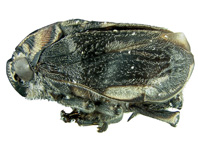Abstract
The tettigoniid subfamily Phyllophorinae, distributed in Southeast Asia and Australia, is poorly known. Our study of the biology of Giant Katydid Siliquofera grandis (Blanchard, 1853) from a laboratory culture has shown that these insects mate more than once, the females lay a total of up to 400 eggs during their life, and these hatch after 2–2.5 months. The life cycle from egg to death takes longer than one year. In the laboratory, the insects fed mainly on leaves of various Rosaceae, Ficus, and lettuce, and on fruits.
It is known that the males of hooded katydids lack the tegminal stridulatory apparatus typical for Tettigoniidae, but are capable of producing protest sounds using their coxosternal sound-producing organs for stridulation. Here, protest stridulation of the males and females and the sound-producing organs used to produce it have been analyzed in Phyllophorina kotoshoensis Shiraki, 1930 and S. grandis. In addition, nymphal protest sounds produced by friction of the metafemur against the edge of the pronotum and adult protest signals produced with the wings are described. In S. grandis, vibratory signals have been described and studied for the first time: territorial, protest, drumming and rhythmic low-amplitude vibrations emitted by adults and nymphs and pre- and postcopulatory vibrations of the males and females. The territorial signals not accompanied with visible movements of the body may be produced by contracting the antagonist muscles of the thorax and possibly of the legs. Using their coxosternal sound-producing organs males of S. grandis produced also an audible courtship song lasting for several seconds. Acoustic signals may thus both regulate intrapopulation relations and serve for interspecific communication (protest signals). The acoustic communication in Phyllophorinae is probably especially important during mating behavior.
References
Ander, K. (1956) Orthoptera Saltatoria. In: Tuxen, S.L. (Ed.), Taxonomist’s glossary of genitalia of insects. Ejnar Munksgaard, Copenhagen, pp. 53–62.
Barrientos-Lozano, L. (1998) Mate choice and hybridization experiments between allopatric populations of Pterophylla beltrani Bolívar and Bolívar and P. robertsi Hebard (Orthoptera: Tettigoniidae: Pseudophyllinae). Journal of Orthoptera Research, 7, 41–49.
https://doi.org/10.2307/3503491
Belwood, J.J. & Morris, G.K. (1987) Bat predation and its influence on calling behavior in Neotropical katydids. Science, 238, 64–67.
https://doi.org/10.1126/science.238.4823.64
Benediktov, A., Korsunovskaya, O., Polilov, A. & Zhantiev, R. (2020) Unusual mechanism of emission of vibratory signals in pygmy grasshoppers Tetrix tenuicornis (Sahlberg, 1891) (Orthoptera: Tetrigidae). The Science of Nature, 107, 11.
https://doi.org/10.1007/s00114-020-1668-z
Boldyrev, B.T. (1915) Contributions a 1’etude de la structure des spermatophores et des particularities de la copulation chez Locustodea et Gryllodea. Hоrae Societatis Entomologicae Rossicae, 41 (6), 1–245.
Carl, J. (1906) L’organe stridulateur des Phyllophorae. Archives des Sciences Physiques et Naturelles Genéve, 4 (22), 406–407.
Caudell, A.N. (1912) Orthoptera fam. Locustidae Subfam. Meconeminae, Phyllophorinae, Tympanophorinae, Phasgonurinae, Phasmodinae, Bradyporinae. In: Wytsman, P. (Ed.), Genera Insectorum. 138. Verteneuil, V. & Dismet, L., Brussels, pp. 1–25.
Chamorro-Rengifo, J. & Lopes-Andrade, C. (2014) The phallus in Tettigoniidae (Insecta: Orthoptera: Ensifera): a revision of morphology and terminology, and discussion on its taxonomic importance and evolution. Zootaxa, 3815 (2), 151–199.
https://doi.org/10.11646/zootaxa.3815.2.1
Cigliano, M.M., Braun, H., Eades, D.C. & Otte, D. (2020) Orthoptera Species File. Version 5.0/5.0. Available from: http://Orthoptera.SpeciesFile.org/ (accessed 22 June 2020)
Cocroft, R.G. & McNett, G.D. (2005) Vibratory communication in treehoppers (Hemiptera: Membracidae). In: Drosopoulos, S. & Claridge, M.F. (Eds.), Insect sounds and communication: physiology, behaviour, ecology, and evolution. CRC Press, Boca Raton, Florida, pp. 305–317.
https://doi.org/10.1201/9781420039337
Gemeno, C., Claramunt, J. & Dasca, J. (2004) Nocturnal calling behavior in mantids. Journal of Insect Behavior, 18 (3), 389–403.
https://doi.org/10.1007/s10905-005-3698-y
Gemeno, C. & Schal, C. (2004) Sex pheromones of cockroaches. In: Cardé, R.T. & Millar, J.G. (Eds.), Advances in insect chemical ecology. Cambridge University Press, Cambridge, pp. 179–247.
https://doi.org/10.1017/CBO9780511542664.007
Heller, K.-G. (1995) Acoustic signalling in palaeotropical bushcrickets (Orthoptera: Tettigonioidea: Pseudophyllidae): does predation pressure by eavesdropping enemies differ in the Palaeo- and Neotropics? Journal of Zoology, 237, 469–485.
https://doi.org/10.1111/j.1469-7998.1995.tb02775.x
Heller, K.-G. (2020 a) Male protest stridulatory sounds of Phyllophorina kotoshoensis Shiraki, 1930 (Orthoptera: Tettigonioidea: Phaneropteridae: Phyllophorinae). Zenodo. [published online]
http://doi.org/10.5281/zenodo.3967523
Heller, K.-G. (2020b) Protest stridulatory sounds of female of Phyllophorina kotoshoensis Shiraki, 1930 (Orthoptera: Tettigonioidea: Phaneropteridae: Phyllophorinae). Zenodo. [published online]
http://doi.org/10.5281/zenodo.3967453
Heller, K.-G., Korsunovskaya, O.S., Sevgili, H. & Zhantiev, R.D. (2006) Bioacoustics and systematics of the Poecilimon heroicus-group (Orthoptera: Phaneropteridae: Barbitistinae). European Journal of Entomology, 103, 853–865.
https://doi.org/10.14411/eje.2006.116
Karny, H.H. (1924) Monographie der Phyllophorinen. Treubia, 5 (Supplement), 1–147.
Latimer, W. & Schatral, A. (1983) The acoustic behaviour of the bushcricket Tettigonia cantans. I. Behavioural responses to sound and vibration. Behavioural Processes, 8 (2), 113–124.
https://doi.org/10.1016/0376-6357(83)90001-3
Korsunovskaya, O. (2020) Video of precopulatory and postcopulatory behavior and copulation of Siliquofera grandis (Orthoptera: Phaneropteridae: Phyllophorinae). Zenodo. [published online]
http://doi.org/10.5281/zenodo.3967363
Morris, G.K. (1980) Calling display and mating behaviour of Copiphora rhinoceros Pictet (Orthoptera: Tettigoniidae). Animal Behaviour, 42 (1), 42–51.
https://doi.org/10.1016/S0003-3472(80)80006-6
Morris, G.K., Mason, A.C., Wall, P. & Belwood, J.J. (1994) High ultrasonic and tremulation signals in neotropical katydids (Orthoptera, Tettigoniidae). Journal of Zoology, 233, 129–163.
https://doi.org/10.1111/j.1469-7998.1994.tb05266.x
Naskrecki, P. (2011) Relics. Travels in nature’s time machine. The University of Chicago Press, Chicago, Illinois, 384 pp.
https://doi.org/10.7208/chicago/9780226568720.001.0001
Rajaraman, K., Godthi, V., Pratap, R. & Balakrishnan, R. (2015) A novel acoustic-vibratory multimodal duet. Journal of Experimental Biology, 218, 3042–3050.
https://doi.org/10.1242/jeb.122911
Rajaraman, K., Nair, A., Dey, A. & Balakrishnan, R. (2018) Response mode choice in a multimodally duetting Paleotropical pseudophylline bushcricket. Frontiers in Ecology and Evolution, 6, 172.
https://doi.org/10.3389/fevo.2018.00172
Rentz, D.C.F. (1996) Grasshopper Country. Sounds of Australia Orthopteroid Insects. CSIRO Publishing, Collingwood, Victoria. [CD]
Rentz, D.C.F., Su, Y.N. & Ueshima, N. (2009) Studies in Australian Tettigoniidae: The Phyllophorinae (Orthoptera: Tettigoniidae; Phyllophorinae). Zootaxa, 2075 (1), 55–68.


